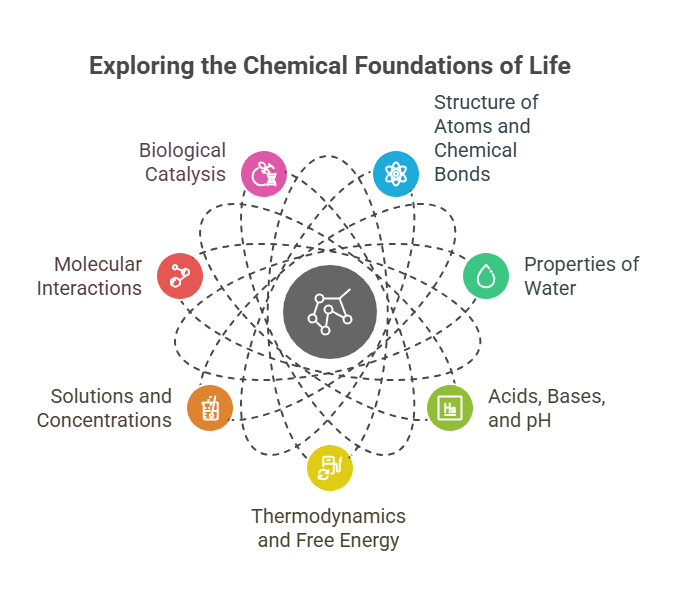
Chemical Basis Explained
Explore the fundamental principles of chemistry that underpin all biological processes and interactions.
Understanding the Chemical Basis of Life
This unit lays the groundwork for understanding all biological processes.
Key Subtopics:
Structure of atoms and chemical bonds
Properties of water and its biological significance
Acids, bases, pH, and buffers
Thermodynamics and free energy
Solutions, colloids, and concentration units
Molecular interactions and biomolecular behavior
Biological catalysis and reactions


Chemical Basis of Life
Understanding the chemical basis of life is like learning the language biology speaks. Before we discuss metabolism, DNA, or disease, we need to grasp the concept of molecules and the various forces that make everything possible in the body.
This unit forms the bedrock of all biochemical understanding.
Let’s walk through each key subtopic in detail
1. Structure of Atoms and Chemical Bonds
At the most basic level, all living things are made up of atoms — protons, neutrons, and electrons. In biochemistry, the focus is on atoms like carbon, hydrogen, oxygen, nitrogen, phosphorus, and sulfur (CHONPS), as they form the building blocks of biomolecules.
Chemical bonds connect atoms into molecules:
Ionic bonds involve the transfer of electrons (e.g., Na⁺ and Cl⁻ in salt).
Covalent bonds involve the sharing of electrons (strong and common in biological molecules, like C-H or C-N).
Hydrogen bonds are weaker but crucial in stabilizing DNA and protein structures.
Van der Waals forces and hydrophobic interactions help shape proteins and membranes.
Why it matters: The type of bonding determines the molecule’s stability, shape, reactivity, and interaction with water — all of which affect how it behaves in the body.
2. Properties of Water and Its Biological Significance
Water isn’t just a solvent. It’s central to life.
Key properties:
Polarity: Water is a polar molecule. This allows it to dissolve ionic and polar compounds, making it the “universal solvent.”
Hydrogen bonding enables cohesion, surface tension, and high specific heat.
Thermal stability: Helps regulate body temperature.
Amphipathic interactions: Drive membrane formation and protein folding.
In your body, nearly all biochemical reactions happen in aqueous (water-based) environments. Understanding water helps you grasp how substances move, react, and are maintained in balance.
3. Acids, Bases, pH, and Buffers (Learn more)
Every biological process is sensitive to pH.
Acids donate protons (H⁺), bases accept them.
pH is a measure of hydrogen ion concentration. Blood pH is tightly regulated at a range of 7.35–7.45.
Even slight deviations can disrupt enzyme activity and cellular functions.
Buffers are systems that resist changes in pH. Major physiological buffers include:
Bicarbonate buffer (in blood)
Phosphate buffer (in cells)
Proteins (like hemoglobin)
As a medical student, you’ll often link buffer systems to clinical conditions like acidosis and alkalosis.
5. Solutions, Colloids, and Concentration Units
In medicine and biochemistry, we often deal with solutions.
Solutions: Solutes (like glucose or ions) dissolved in solvents (usually water).
Colloids: Larger molecules dispersed in solution (e.g., plasma proteins).
Concentration units: mmol/L, mEq/L, mg/dL — used in labs and prescriptions.
Why it's important: Understanding how to interpret lab values and prepare dilutions accurately relies on mastering these basics.
4. Thermodynamics and Free Energy
Biological systems follow the laws of physics. Thermodynamics helps you understand:
How and why reactions occur
Which reactions release energy (exergonic) and which require energy input (endergonic)
The key concept is Gibbs Free Energy (ΔG):
If ΔG is negative, the reaction is spontaneous (favorable).
If ΔG is positive, the reaction needs energy to proceed.
Cells use ATP as an energy currency, coupling energy-releasing and energy-consuming reactions. You’ll encounter this constantly in metabolism and physiology.
6. Molecular Interactions and Biomolecular Behavior
This involves how molecules interact in a cell:
Enzyme-substrate binding
Antigen-antibody interactions
Hormone-receptor signaling
Non-covalent interactions (like hydrogen bonds, ionic interactions, hydrophobic forces) are key to molecular recognition and specificity.
Clinical example: Many drugs act by mimicking or blocking these interactions — think of insulin binding to its receptor, or beta-blockers inhibiting adrenaline.
Final Thoughts
This unit may seem theoretical at first, but it's the key to understanding how life functions at the molecular level. From enzyme deficiencies to acid-base disorders, everything ties back to these fundamental chemical principles.
Take time to understand this unit deeply — it will make everything else in biochemistry (and medicine) much clearer.
7. Biological Catalysis and Reactions
Biochemical reactions in the body would be too slow to sustain life without enzymes — biological catalysts that speed up reactions without being consumed.
Key points:
Enzymes lower the activation energy of a reaction.
They are specific to substrates and conditions (pH, temperature).
They often require coenzymes or metal ions (e.g., B-vitamins, zinc).
Understanding enzyme kinetics, inhibition, and regulation lays the foundation for topics like metabolic control, pharmacology, and clinical diagnostics.
BLOG
Join us to explore medical biochemistry intricacies.
WRITE TO US
© 2024. All rights reserved.
